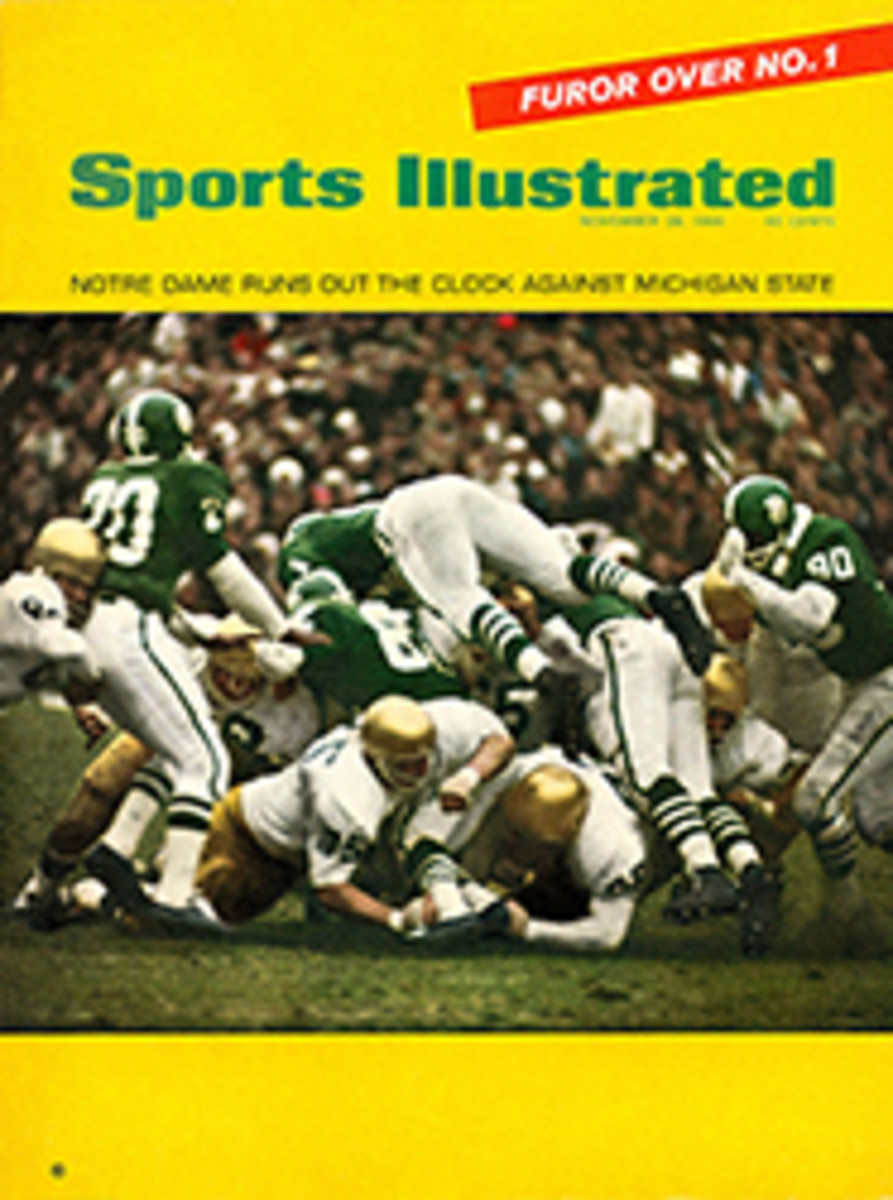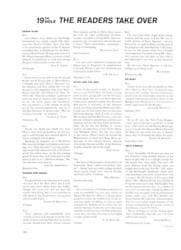
UNTROUBLED SPORT FOR THOSE WHO PLAY VAAGG
If you were to bet that 90% of the people who play at—and note that I say "play at"—golf cannot break 100 without cheating, you would make money. You would, that is, if you could find anybody foolish enough to bet against you. Cheating, of course, includes conceding yourself three-foot putts, improving your lie in the rough, grounding your club in the bunker and playing winter rules when the sign by the first tee says SUMMER just as plain as your reflection in a water hazard.
What this means is that despite endless lessons, graded woods (one to four), graded irons (two to 10), a golf bag big enough to house an elephant, glove, cap, shoes, windbreaker, gooseneck putter and aerodynamically flawless ball, 90% of golfers are still hackers.
This is a sad state of affairs, and it is a lucky thing that the vast, unhappy and yet blindly dedicated army of 7.2 million hookers, slicers, toppers and three-putters who make up the lower 90% of the golfing fraternity never analyze golf as it relates to their own game. If they did they would be queued up for miles around the George Washington Bridge waiting for their turn to jump into that big lateral water hazard that borders Manhattan.
I do not mean to imply that hackers are insensitive about their golf. Quite the contrary. Many is the time I have seen the blood drain from a duffer's face and his eyes bug out as he sees the first drive he has connected with all day sail out-of-bounds, or his best approach shot catch a bunker. I have shared these emotions. I understand them. I commiserate. What is more, I intend to do something on behalf of all of us who suffer them.
Anyone who contends that these tribulations subconsciously give pleasure to the average golfer is talking through his Freud. The effect on the human nervous system approximates that experienced by a mountain goat hit by a soft-nosed bullet fired by a concealed hunter. He knows he has been hit, but by what and from where he has no idea. The only difference between me and my wounded brothers is that I do know what has hit me and where the bullet comes from. And I say that if golf as now designed cannot bring happiness to 90% of its players, the game needs changing.
My theory is that it must be the setup of the game and not the golfer's poor play that is the cause of all this weeping and gnashing of teeth. Maybe the game is geared too high for the lower 90%, maybe the penalties, such as bunkers, water hazards and out-of-bounds, are too severe. Perhaps the 90% are penalized 90% more per capita than the upper 10%. The problem, as I see it, is how to make pleasure out of torture for the majority of golfers.
In exploring this provocative possibility I have used the same technique that I did in simplifying lawn-tennis scoring by inventing VASSS. I have listed the negatives first:
1) A round of golf takes too long, at least four hours on the course plus one to get out and back—five hours in all. A complete morning or afternoon shot.
2) There is not enough exercise involved in a round of golf for the time spent playing it. No matter how much you zigzag back and forth across the average course (6,500 yards), you won't walk five miles. This means that golf can only be rated as a leisurely pastime and cannot be considered as real exercise. If you want exercise you must find some other way to get it. This is a most important point realized by few and admitted by fewer. You need no slide rule to figure that, even supposing you did walk five miles, you would only be averaging 1.25 mph, which is about as near to standing still as you can get and stay in motion. If you use a golf cart you might just as well be in a hammock.
3) There is not enough club action, not enough swinging. Essentially the game is supposed to be one of hitting a ball, but that is the thing you spend the least time doing on a golf course. Suppose you are a 125-shooter, which is a pretty dreary supposition, I admit. Allowing two putts per hole, which is highly optimistic, you will be hitting the ball, as opposed to putting it, only 125 times minus 36, or 89 times in four hours, which is about once every three minutes. This means there is enough time elapsing between shots for you to lose continuity completely. You forget what it felt like to hit the ball in the first place. For those who are interested in improving, the silly fact is that the better you play the less play you get.
4) There are too many clubs in the bag that the hacker finds difficult to handle. By "handle" the club I mean use it to get the ball in the air and keep it reasonably straight. In this respect the driver is the worst. It has the longest shaft and the straightest face of any club, which means it is the hardest club with which to keep the ball on line and in the air. Yet it is the club that is used on almost every hole. But the driver is not the only snake in the golf bag, not by any means. The two-, three-and four-woods and two-, three- and four-irons are troublemakers, too. It is not until the golfer gets down to the faithful mashie (five-iron ) that he begins to feel some security, for the mashie hits the ball straighter than any of the more powerful clubs and can be used in a variety of ways for shorter shots.
Having taken golf apart, all we have to do is put it together again, using only the good parts and leaving out the bad. As I see the game, I want: 1) a round to take half of the present four hours so that I can use the other half for some real exercise, 2) to hit and putt the ball twice as many times per hole as I do at present and 3) to hit the ball straight down the middle of the fairway and not waste my time and patience combing through the bushes for it.
To arrange this is easier than you think.
First: you play nine holes—not 18—in a round.
Second: you take a mulligan on every shot—not just off the first tee. This means you hit two shots off the tee and select the ball with the better lie for your second shot. You then hit two second shots and select the better lie for your third. You continue this selective plan until you hole out.
Third: you use that most honest of all clubs, the mashie, from tee to green. Once on the green, you use a putter.
That's all you need to do.
Before I get drowned out by the cries of indignant purists, I would like to make a closing statement. I have used this formula with complete and gratifying success many times and have enjoyed the type of competition that it produces far more than ordinary golf. In addition, while testing it, I have made some interesting discoveries:
1) The time wasted per round hunting for lost balls in normal golf is far greater than the time spent taking second shots and picking up the extra ball.
2) A firm friendship is established with one club instead of a nodding acquaintance with 14. You learn how to control the length of your shots by cutting down on the swing and/or shortening up on your grip. You also learn that it is possible, by laying back the face of your mashie, to blast out of bunkers.
3) You are your own man, the master of your ship. You need no caddie. You make your own decisions. Instead of taking as gospel an opinion on distance from a downy-faced juvenile who quite possibly has severe myopia, you make up your mind for yourself.
4) When you travel, two clubs handily packed in a Navy officer's sword cover are far handier and lighter than a voluminous bag containing 14.
5) The course, with its traps and hazards, loses its terror for you, since you can repair the damage done by a ball hit out-of-bounds or into a bunker by using more discretion with your mulligan. On approach shots and putts you can take advantage of what your first ball showed you about distance, rolls in the green, etc. as you hit your mulligan. This also limits your brooding. You forget your inept first shot and only remember your cagey second.
6) It evens up golfers of different caliber. The good player may hit both his approaches onto the green, but he can only play one of them. The poor golfer can hit his first shot into the bunker and still be even by getting on with his mulligan. With selective putts, it is amazing how equal the game becomes.
7) When you repair to the 19th hole you can happily go over a round in which the fairway has been your twin brother, not a fourth cousin once removed, and you can gloat over hitting more good shots in nine holes than you normally hit in a hundred and nine.
So there you have it, VAAGG (Van Alen's Answer to Grief in Golf). It works as advertised, it produces golf without tears, it is the hacker's delight.
What is that you are saying, my friend? VAAGG isn't really golf at all? Well, I didn't want to mention it, but neither is the game you have been playing.
ILLUSTRATION

